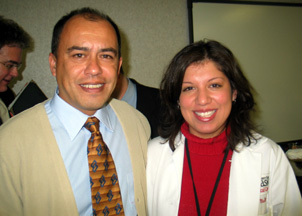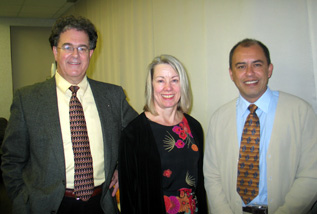 |
Alfredo Garcia, M.D., MPH, adjunct associate professor with UNMC, and Tina Flores, M.D., assistant professor in the department of family medicine. Dr. Flores was among the first group of students to go on the first medical Spanish trips to Guatemala in July of 2000. |
“Students will be visiting Jamaica, Nicaragua, Guatemala and a Native American reservation in South Dakota,” Sara Pirtle recently told those present at the annual holiday luncheon for International Studies and Programs.
Pirtle, who is coordinator of IS&P, and advisor for SAGH, said many students have shown an interest in participating in medical service trips.
“We started in 1996 offering just one trip, and 11 students participated,” Pirtle said. “We now are offering five one-week medical service trips per year, and may increase that number in the future.”
 |
Tom Gouttierre, dean of International Studies and Programs at UNMC and the University of Nebraska at Omaha, Sara Pirtle, coordinator of IS&P and advisor for SAGH at UNMC, and Alfredo Garcia, MD, MPH, adjunct associate professor with UNMC. Dr Garcia is the on-site coordinator of UNMC’s four-week Medical Spanish/International Health Courses in Guatemala. |
“The students spend three intense weeks learning the Spanish language and living with a local family, followed by one week working in clinics where they will see between 40 to 60 patients per day,” Dr. Garcia said.
Dr. Garcia and Pirtle first initiated the popular Medical Spanish/International Health programs in the summer of 2000, with 16 total participants for the June and July programs.
In response to the high demand nation-wide for quality medical Spanish training, the course is now offered six to eight times per year, and attracts not only UNMC students (who are given first-priority), but medical and health students, residents, and faculty from all across the United States and Canada.
During the calendar year of 2004, 86 participants (34 from UNMC) completed the four-week course. Certain months of the year are so popular for the course that some students have to be put on waiting lists, they said.
The medical service trips and the Medical Spanish/International Health courses are once-in-a- lifetime events the students never forget, Pirtle said.